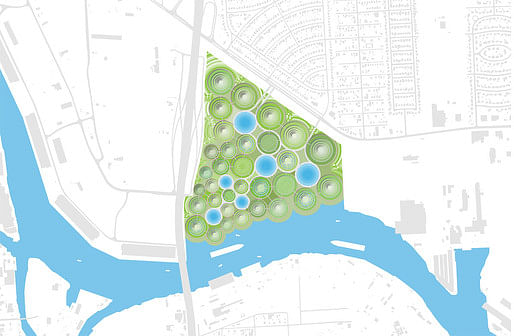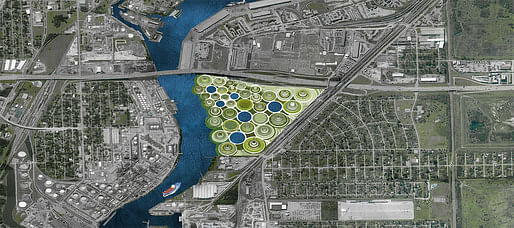
In anticipation of today's event, Publish Or... bracket [GOES SOFT], we are showcasing a piece from the book each day this week. We hope to see you tonight!
Dredge Locked
by Alex Yuen
Unnoticed by many, Houston’s shipping channel, like many such commercial waterways around the globe, is subjected to a continual process of dredging, in order to maintain a certain breadth and depth to accommodate the vessels that enter and leave Houston every day. This material, however, is seldom regarded as anything but waste and is deposited and contained, either within the channel or on shore, taking up space and spreading the harmful bi-products of the petrochemical facilities in the area. Up to this point, such actions have rarely been scrutinized and this system of isolating and hiding the contaminated material, even at such a massive scale, continues. Yet as the world and Houston move into a new era of awareness and accountability, major possibilities are lost by simply sweeping these materials under the rug.
“Especially near coastal areas, where the need for confined disposal facilities (for dredging) is the greatest, the competition for other land uses such as housing, recreation, and nature reserves is great”
- The International Association of Dredging Companies

Image: The proposed system addresses the treatment of dredged material and the process of remediation, to foreground water treatment and topography in Houston.
Dredge Locked proposes to reverse this consensus by ending said competition and capitalizing on dredging containment to be used as a means to open up alternative urban possibilities. The project is a system of containment and remediation of dredged materials. While deployed in Houston, the system has applicability to any number of regions where dredging occurs.

Image: A new hybrid infrastructure serves as a container for dredged material, a fi lter for contaminated liquid and housing units or parking structures, becoming the main building block for a new ecology and urbanity.
The project is based on cycles of remediation to account for the contaminated water that makes up a large portion of what is dredged from the channel. Before any dredging is dumped on site, morsels of land are excavated and wetlands are established within them. These wetlands serve as the primary zones of phytoremediation, where plantlife, algae, and bacteria absorb or breakdown toxins present in the effluent from the initial dredging dumps. Once these wetlands are established, a reengineered form of the dikes currently used to contain dredged material is put into place. These Locks, which are circular in shape but also quadrisected by two tube-like forms, play a number of roles over time. Initially, they serve to contain dredged material which is pumped directly on land from boats in the channel. Once the slurry begins to separate, with sediment dropping to the bottom and water heading to the top, the quadrisecting tubes act as filters to attract and direct leaching liquid into the wetlands. When the Lock’s contents have dried, plants and vegetation can be grown, establishing another zone of phytoremediation to account for the runoff produced by placing another, smaller, lock on top of the original. What results is a long-term system of storage and remediation, which over years will cleanse the contained material of its contaminants while creating artificial mounds of greenery and plant life.

Image: The project attempts to counter the notion that dredging containment necessarily comes at the cost of other natural or recreational experiences.
Once the Lock’s remediation responsibilities are over, it begins to accommodate human habitation within its poché and the drying of the dredged material opens the door for housing to slowly colonize the accumulating mounds. Dictated by time and the need for containment, the continued implementation of the system gradually transforms the site from disposal facility to inhabited community; where residents, attracted by the possibility for topography in Houston, experience the project grow around them. Situated somewhere between infrastructure and architecture, container and residence, and confined disposal facility and oversize planter, the functional flexibility of the Lock defines a unit that can be configured and stacked in infinite combinations. When amassed, over time the system gives rise to a region that for a generation fluctuates between industrial site, urban wetland, residential community, and emerging mountain range.

Image: The process would play out over years, creating a dynamic landscape of dredging, emerging greenery, and housing.

Image: The vision for the project after its final phase is of a new, highly green community which is driven by its adjacency to one of Houston’s major water elements and its radical topography which redefines the city's landscape.

Image: Located just east of the I-610 belt, the site of the proposal fi nds itself at the confl uence of the urban, the suburban, and the industrial. Continually growing towers of remediation make up the new development. Vegetation covers the earthy material held within the lock, a new type of containment in an area already very familiar with petrochemical storage.
Alex Yuen is an undergraduate student at Rice University where he is a candidate to receive his Bachelor of Architecture degree in 2014.
Previously featured bracket [GOES SOFT] projects.
No Comments
Block this user
Are you sure you want to block this user and hide all related comments throughout the site?
Archinect
This is your first comment on Archinect. Your comment will be visible once approved.